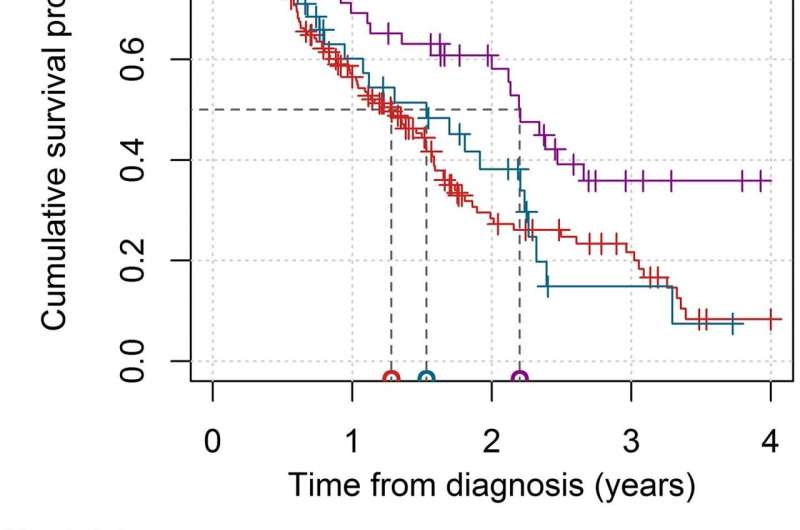Survival curves in the KRAS, EGFR, and niche mutations cohorts. The red line represents the KRAS cohort, the purple line represents the EGFR cohort and the blue line represents the niche mutations cohort. The median survival times for the three cohorts are reported on the horizontal axis. The number of patients at risk at 0, 1, 2, 3, and 4 years from baseline is reported. Thick marks represent subjects lost to follow-up. Credit: Correspondence to: Beatrice Aramini, beatrice.aramini@unimore.it
The cover for issue 5 of Oncotarget features Figure 2, "Survival curves in the KRAS, EGFR, and niche mutations cohorts," by Aramini, et al.
Dr. Beatrice Aramini from the Division of Thoracic Surgery in Department of Medical and Surgical Sciences at the University of Modena and Reggio Emilia in Modena Italy said in their Oncotarget Research Paper, "In the last century, carcinoma of the lung has progressed from an uncommon and obscure disease to the most common cancer in the world, and the most common cause of death from cancer."
In addition to these somatic mutations, which are the most frequent, other mutations in several genes have been discovered, including BRAF, c-MET, DDR2, HER2, MAP2K1, NRAS, PIK3CA, and RET mutations.
Oncotarget interviews Dr. Beatrice Aramini from the University of Modena and Reggio Emilia in Modena Italy about their Featured Cover Paper for Volume 11 Issue 5 titled "Overall survival in patients with lung adenocarcinoma harboring 'niche' mutations: an observational study" Credit: Oncotarget
Moreover, the prevalence of the RET mutation in adenocarcinoma was estimated to be 1.7%, and the prevalence of DDR2 mutation in lung cancer was 2.2%.
With regard to treatment, discoveries of gene mutations have allowed the development of targeted therapies, which are considered more effective for survival than chemotherapy in patients with advanced mutated disease.
Oncotarget interviews Dr. Beatrice Aramini from the University of Modena and Reggio Emilia in Modena Italy about their Featured Cover Paper for Volume 11 Issue 5 titled "Overall survival in patients with lung adenocarcinoma harboring 'niche' mutations: an observational study" Credit: Oncotarget
Considering the potential aggressiveness of niche mutations in this context, the technological advances of next-generation sequencing, which is currently used in clinical practice, represents a precise approach to identifying a large panel of mutations in oncologic patients.
The Armini Research Team concluded, "The correct selection of mutations will be helpful in terms of the greater efficacy of treatment in association with better prognosis and a higher quality of life for oncologic patients."
More information: Beatrice Aramini et al, Overall survival in patients with lung adenocarcinoma harboring "niche" mutations: an observational study, Oncotarget (2020). DOI: 10.18632/oncotarget.27472
Journal information: Oncotarget
Provided by Impact Journals




















